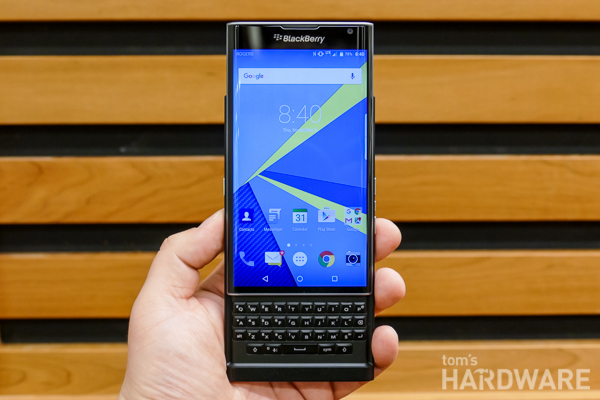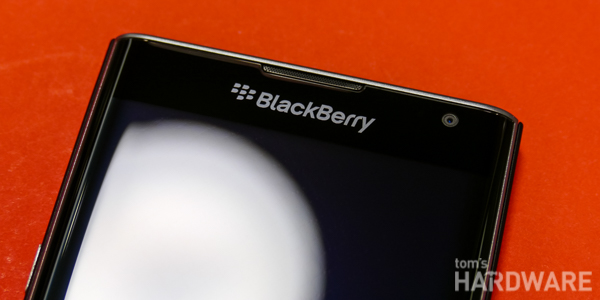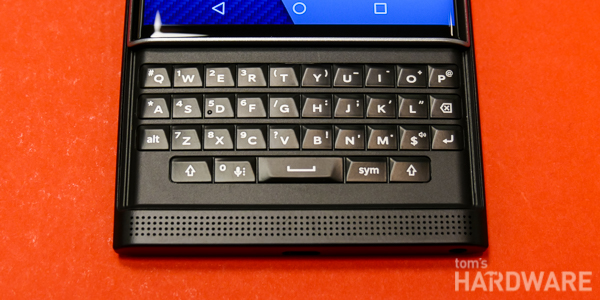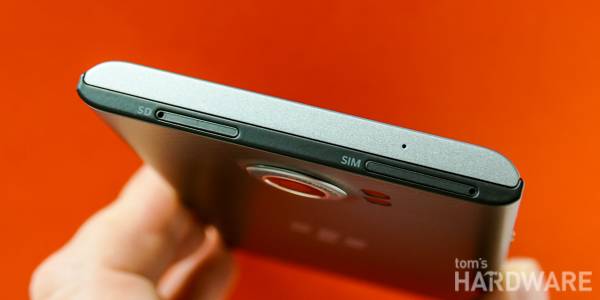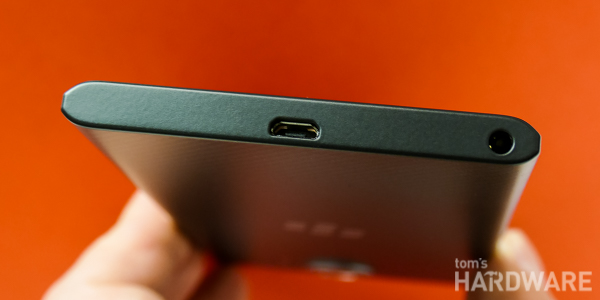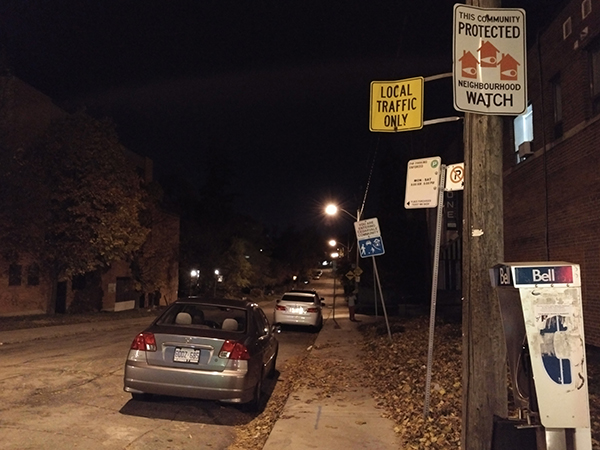BlackBerry's Back: The Android-Powered Priv, First Hands-On Impressions
When we were in Barcelona way back in February, Ron Louks, BlackBerry's head of devices, briefly teased a curved-screen slider phone at the end of its Mobile World Congress presentation. It looked very slick, a potential comeback device, but the brief reveal left us with many questions that wouldn't be answered for months. Still, it gave die-hard BlackBerry fans hope that it could still pull something amazing out of the bag after its slow and steady decline in handset market share.
It wasn't until earlier this summer that we started to hear more about this upcoming device (then called the "Venice"), and all the rumors pointed to it running Android instead of BlackBerry's in-house OS BlackBerry 10 (BB10). Although this was probably a disappointment to many fans of the Canadian company, realistically, we all knew that if it was going to stay in the device game, moving to Android was the BlackBerry's only option and the only way to close the app gap.
In the fall, the rumors turned to a deluge of leaks with pictures and even hands-on videos of an Android phone BlackBerry had yet to announce formally. When it did confirm its existence at the end of September, we learned that it was to be called the "Priv" and that it "combines the best of BlackBerry security and productivity" with Android.
Although all the unofficial info pointed to what looked like a great device, we were still skeptical. We questioned if BlackBerry still had the expertise to build a secure OS and software on a completely new platform, especially after the talent departures from all the layoffs. We also weren't sure if a device with a hardware keyboard, slide-out or not, was still viable in this age of all-touch phones.
To answer those questions, BlackBerry was able to get us a demo unit, and we've been testing it out for the past week. We know our headline makes a bold statement, but it isn't mere hyperbole. The Priv hits the mark in so many areas, from its FIPS 140-2 certified enhanced security, hardware specs, design and software, and in the short time we've had it, we've been seriously impressed.
Specifications
| SoC | Qualcomm Snapdragon 808 64-bit Processor (2 x Cortex-A57 and 4 x Cortex-A53) with X10 LTE and an Adreno 418 600 MHz GPU |
|---|---|
| Display | 5.43-inch Curved Quad HD Plastic AMOLED Display (2560 x 1440, 540ppi) with Gorilla Glass 4 |
| Keyboard | Capacitive touch, capacitive 4-row keyboard (slider) |
| Memory | 32 GB eMMC ROM, 3 GB LPDDR3 RAM / microSD slot (up to 2 TB) |
| Camera | Rear: 18MP with f/2.2 lens & 1/2.4" Sony Exmor RS IMX230 sensor / OIS / PDAF / Dual-color dual LED flash / 4K VideoFront: 2MP with f/2.8 lens and wide selfie mode |
| Battery | 3,410 mAh (non-removable), Quick Charge 2.0 enabledU.S. model only: Dual mode wireless charging (PMA and Qi) |
| Operating System | Android 5.1.1 Lollipop with BlackBerry apps |
| Size & Weight | 147 (184 opened) x 77.2 x 9.4 mm, 192g |
| Network | 4G / LTE cat. 6 / HSPA+, Nano SIMSTV100-1 model: LTE Bands 1, 2, 3, 4, 5, 7, 12, 17, 20, 29,30 |
| Connectivity | Wi-Fi 802.11 a, b, g, n, ac 2x2 MIMO / Bluetooth 4.1LE / NFC / SlimPort enabled USB 2.0 |
| Biometrics | No |
| Audio | Front-facing mono speaker |
| Materials | Metal, plastic, glass fiber |
| Colors | Black |
| Retailers/Carriers | U.S.: Unlocked from BlackBerry and B&H, AT&TCanada: Unlocked from BlackBerry, CrackBerry and NCIX. Bell, Eastlink, Rogers, SaskTel, Telus, Wind Mobile. |
| Pricing | U.S: $699 US outrightCanada: $899 CDN outright |
A Signature Feature You Never Have To Use
Let's start by talking about the hardware keyboard, the signature feature of nearly every BlackBerry phone and what sets them apart from everyone else (yes, we do know there are some all-touch BlackBerrys, too). On the Priv, it slides out from the bottom with a satisfying snap (with just the right amount of force needed to activate the movement), the same way as the awful BlackBerry Torch and the not so awful Dell Venue Pro (a short-lived Windows Phone from 2010).
The backlit four-row keyboard is well laid out, and the keys have a nice tactile feel, but due to the constraints of the width of the Priv, the keys are on the small side. The whole thing does feel a bit cramped, especially when compared to the spacious keyboard of the Passport, but for users used to the smaller keyboards on other BlackBerrys like the Classic, the Priv's keyboard is going to offer a similar (as in good) typing experience.
Get Tom's Hardware's best news and in-depth reviews, straight to your inbox.
The Priv is also perfectly balanced, even when the keyboard is open. When the screen slides up, the weight doesn't shift much, so it isn't top heavy. When you flip it over, you can see that BlackBerry has carefully engineered the sliding display to be as light as possible while still being very rigid.
The beauty of the Priv's design is when you don't need the keyboard, it just slides away -- this applies to both hardware keyboard lovers and those who don't ever think they'll use it. When closed, the Priv is as almost slim (with the curved sides making it feel even thinner) as many of the leading smartphones that don't have this feature, so if need be, you can simply pretend it's an all touch phone. The onscreen BlackBerry keyboard is also excellent and is an Android enhanced version of BB10's soft keyboard with the same feature of word suggestions that you can use an upward flick gesture to select.
There is also one bonus feature of the keyboard that I've fallen in love with. The entire keyboard is touch sensitive (like the Passport's) and acts as a trackpad below the screen. Even if you never type on it, the keyboard is awesome for scrolling through web pages, long emails, and your Twitter feed without ever having to touch the screen. There are some other neat tricks that you can perform with this feature, such as being able to move the cursor around when composing text. Other features of the keyboard also include being able to assign shortcuts (such as opening a particular app) when long pressing on a key, and typing on the keyboard on the home screen starts a universal search.
Curved, But Not That Curved
The other hardware feature you'll notice immediately is the Priv's curved display. At first glance, it looks to be the same as the curved screens on the Samsung Galaxy S6 edge and edge+, but on closer inspection, the curve of the Priv's screen doesn't wrap around the edges as far as its Korean rivals'.
The Canadian phone has wider bezels on the sides of the display, which means that despite having a smaller 5.4-inch display, the Priv is still a big phone and is a similar size to other Android devices with 5.7-inch screens such as the Nexus 6P and Galaxy Note 5, at least in width. Both those phones are taller than the Priv, but overall none of these phones are practical to use with one hand.
The screen itself is a plastic AMOLED QHD panel covered in Gorilla Glass 4 that has impressed in the short time we've used the Priv, but we haven't been able to test its brightness or color accuracy yet. Naturally, being an AMOLED panel, the Priv display's colors err on the over-saturated side, but not unpleasantly so, and in the settings you can adjust both white balance and saturation if the defaults are not to your liking.
The curved sides of the Priv's screen aren't utilized as much as those of its Samsung competitors; one reason for this, of course, is that its gentler curve allows for less area for the software to utilize. That means there is no equivalent to the edge display features of the Galaxy S6 edge. What BlackBerry does use it for is to show a battery level bar that runs down the side when charging and for a tab that, when swiped, opens an overlay that lets you peek at your current calendar events, unread messages, tasks and shortcuts to your favorite contacts. The Priv also supports Google's ambient display feature, so when you get a new notification with the phone asleep, you'll see it in the middle of the darkened screen in white.
Premium Materials And Design
Despite the shortcomings of the BB10 OS on its previous flagship devices, there's no argument that BlackBerry's flagship phones have always been well-designed devices made from premium materials. Metal has long been a major aspect of its high-end phones, along with attractive (though certainly more professional than fashionable) design and other durable materials. For example, although the Passport wasn't a device I'd own due to its oddball form-factor, the recently released Silver Edition is one of the best-looking handsets to come out this year.
The Priv is no different; it's a solid-feeling device that stands out from a sea of similar-looking Android phones with its curved screen, metal accents, and matte black sides. There are only two misses for me in its design: The soft-touch finish of the curved back (that looks to be the same material used on the Q10 and Z30) isn't as nice as the textured back of the Silver Edition Passport. I'm also not a big fan of the polished metal power and volume controls. A brushed-metal finish similar to the surround of the screen would have looked better.
(Almost) Premium Specs Combined With A Huge Battery
As you can see from the specification chart above, the Priv is powered by Qualcomm's Hexa-Core Snapdragon 808 SoC. This chip is certainly one of the most powerful mobile SoCs available, but it isn't the best, and at the Priv's price point there may be an expectation that one would get the best of the best. However, although the issues with the more powerful Snapdragon 810 have been conquered by many OEMs, it's still a hotter and more power-hungry chip. With the Priv's sliding screen restricting the space in the lower-half of its chassis, perhaps it just wasn't feasible to squeeze in the 810.
Other than the SoC, everything else about the Priv's internal hardware is top-end, with 3 GB of RAM, 32 GB of storage, microSD expansion and a huge 3,410 mAh battery. The combination of this battery and the 808 SoC should lead to impressive battery life, but this is something we still need to test, of course. So far, our experience with the Priv has shown that getting a full day of use out of it won't be a problem – BlackBerry claims you'll get up to 22.5 hours of mixed usage. It also supports Quick Charge 2.0 and dual mode (PMA and Qi) wireless charging, at least that is for models sold in the U.S. For some reason, the Canadian model does not have wireless charging.
The Priv's front-facing speaker below the screen is unfortunately not stereo, but it is very loud, so although it's perhaps not the best for music or video, it's going to be great for speakerphone conference calls. The Priv does not have a fingerprint reader, and for such a security-focused device, that's a perplexing omission. It also still uses a USB 2.0 port for charging instead of a USB Type-C port.
Camera That Checks All The Boxes
Although previous BlackBerrys have had decent cameras, this aspect wasn't ever something that particularly stood out. The Passport's 13MP camera was the first that BlackBerry seemed to pay a bit more attention to, having OIS (optical image stabilization) and an f/2.0 lens, and the Priv's 18MP camera is even better (apart from its aperture). It's certified by Schneider-Kreuznach and has OIS, PDAF (phase detect autofocus), a 6-element f/2.2 lens, a dual-color dual LED flash and shoots 4K video.
The one question we initially had about the camera was whose sensor did it use, because we couldn't think of an 18MP sensor that had those features listed. What we discovered from talking to BlackBerry is that it isn't actually 18MP, but a larger sensor that is cropped due to the need to have the optics closer to the sensor than normal. This is so the camera package can still be slim enough to fit in the space of the lower-half of the Priv's chassis and still incorporate OIS. Knowing that, and looking at the list of features, we can deduce that the sensor is most likely a cropped 21MP Sony IMX230 Exmor RS, one of the best currently available. This sensor, combined with OIS, should allow for excellent low light photos, a weakness of so many phone cameras.
Again, we haven't had the Priv long enough to test out its camera properly, but our initial impression is that it is capable of shooting comparable images to some of the best smartphone cameras, which is impressive. Our only disappointment so far is that its camera software is currently fairly basic, with no manual controls. What's worse is that the Priv's OS does not support Google's Camera2 APIs, so you can't use a third-party camera app for manual control. We hope this is something BlackBerry will fix soon, and the camera app has already been updated since we started testing the Priv to address multiple issues, such as focus time and image processing speed.
Security-Focused (Almost) Stock Android
Although the Priv's hardware is excellent, the real story of this phone is its software, as it's the first BlackBerry to run Android. Despite the fact that BB10 could run Android apps, they could only be acquired through the Amazon App Store (with its limited selection) or sideloaded, and even then, without Google Play Services many didn't work. Yes, you could hack BB10 to install Play Services and even the Google Play Store, but this wasn't something the average user could do. The Priv is a "proper" Android phone with full access to the Play Store.
There are many who think that BlackBerry should have switched to Android sooner, but to be honest, until Lollipop, we don't think that Google's OS was secure enough of a base on which to build a fully secure platform. Even then, BlackBerry has still had to do a lot of work in further enhancing and hardening Lollipop. BlackBerry also announced this week that it will commit to providing at the least monthly security updates to the Priv that will not be controlled by carriers, and that it will also push out hot fixes for critical security issues soon after the vulnerabilities are identified and patched.
Despite the additional work under the hood, BlackBerry has wisely kept the Priv's UI and UX close to stock Android Lollipop, with all its Material Design flourishes. The overall look and feel of the Priv is similar to a Nexus device running Android 5.1.1, with the same standard quick settings panel, Lollipop-style notifications, dialer, settings menu and more. It's not completely stock, though, and the Priv has a modified launcher with a vertically scrolling app drawer, optional pop-up widgets, and a complete different multi-tasking screen with a tiled layout.
Along with all the hardening of the OS, BlackBerry has also ported over some of the best features of BB10 to Android, such as the BlackBerry Hub, one of the best universal inbox applications available. It also naturally comes with BBM and other core BlackBerry apps, such as an improved calendar. All of these applications are found in the Play Store, so they can be updated independently of the core OS. That's a good thing for early adopters, because we have seen some instability and app crashes while using the Priv, and we have already received updates to many of its BlackBerry apps over the past week to fix these problems.
Another significant application is DTEK by BlackBerry, which scans the phone for security issues, such as what kind of screen lock you have set, and it makes suggestions on how to improve the phone's security level. The app also gives you more insight into application permissions, but because the Priv is not running Marshmallow with its improved permissions control, you don't have granular control of these permissions. Another security feature for business users is the ability to separate work and personal data on the same device. Surprisingly (given that BlackBerry pioneered this feature in BB10), the Priv uses Google's Android for Work instead of an in-house solution.
Since there is much to talk about when it comes to the Priv's software, we can't go over all of it in this first-look, but it's easily the most impressive part of the phone. When we heard that BlackBerry was going to go Android, we didn't know what to expect. We weren't sure if it was going to try to recreate every aspect of BB10, including its gesture-based UI but with Android (which would have been a disaster), or create a heavily-skinned security-focused fork of Google's OS.
By doing neither of the above and creating an OS that is on the surface familiar to Android users, the Priv becomes easily accessible and enticing to users of other Android devices. At the same time, bringing over the best of BB10 to Android not only improves the OS but also helps make the transition to Android easier for those coming from BB10. Finally, for users whose primary focus is security, the stock Android UX of the Priv is superior to that of other hardened Android devices like the Blackphone or the Granite Phone.
I'm sure one of the questions at the top of everyone's mind is when the Priv will get Android 6.0, and as of now the best answer we could get from BlackBerry is the "new year." Because it has more work to do hardening and securing the base OS that most other Android OEMs don't have to do, it's no surprise that it will take a little longer to get the update out. To be honest, though, Marshmallow doesn't have enough major differences to Lollipop to make its absence from the Priv a significant issue.
Everybody, BlackBerry's Really Back
It looks like BlackBerry has succeeded on nearly every front (both hardware and software) in making an outstanding mobile device that you'll want to own. The Priv looks great, is made from premium materials and has powerful specs, a huge battery and an excellent camera. It also runs a hardened version of Android Lollipop, yet comes with an almost stock UI instead of an overbearing and unattractive skin. There is very little app bloat, and the additional BlackBerry-included apps only improve on the core Android experience rather than detract from it, as so many OEMs applications do.
There is more to the Priv (especially its software), much more so than many of the other recently-released Android handsets that have started to become more of the same. But that goes beyond the scope of this article.
The BlackBerry Priv is available in the U.S. and Canada directly from BlackBerry unlocked for $699 USD and $899 CDN. Although those prices aren't exactly low, after using the Priv, we'd have to say that they are fair. This is a premium phone that is comparable in every way to other premium Android devices, and the Priv's pricing compares favorably, as well.
Yes, the argument could be made that perhaps BlackBerry should have sold it at a lower price to make it accessible to more people, but we see this as a halo device designed to showcase what it can do with Android, expertise that may then trickle down to future cheaper devices. Still, if some of the Priv's unique aspects (extra security, keyboard) are not as important to you, there are quite a few other Android devices (like the Nexus 6P) that are as good as the Priv but considerably cheaper.
The unlocked model bought directly from BlackBerry will start shipping on November 9. It is also available from various retailers and carriers starting today. In the U.S., it will be sold by AT&T and B&H, and in Canada by Bell, Eastlink, Rogers, SaskTel, Telus, Wind Mobile and NCIX.
Update, 11/6/15, 10:30am PT: Minor change to wording in camera section clarifying aperture differences.
Alex Davies is an Associate Contributing Writer for Tom's Hardware, covering Smartphones, Tablets, and Virtual Reality. You can follow him on Twitter.
-
BoredSysAdmin The Passport’s 13MP camera was the first that BlackBerry seemed to pay a bit more attention to, having OIS (optical image stabilization) and an f/2.0 lens, and the Priv’s is even better (on paper). It’s certified by Schneider-Kreuznach and has OIS, PDAF (phase detect autofocus), a 6-element f/2.2 lens.....":Reply
f/2.2 lens is not better than f/2.0 - it's quite the opposite.
Lower f-stop number = wider open aperture = more light comes in = Low light ISO could be decreased = The captured photo is less likely to have noise coming from high iso due to sensor limitations.
LG G4 with similar (if not same sensor) but with f-stop of 1.8 can do much better low light images than f2.2 -
alex davies ReplyThe Passport’s 13MP camera was the first that BlackBerry seemed to pay a bit more attention to, having OIS (optical image stabilization) and an f/2.0 lens, and the Priv’s is even better (on paper). It’s certified by Schneider-Kreuznach and has OIS, PDAF (phase detect autofocus), a 6-element f/2.2 lens.....":
f/2.2 lens is not better than f/2.0 - it's quite the opposite.
Lower f-stop number = wider open aperture = more light comes in = Low light ISO could be decreased = The captured photo is less likely to have noise coming from high iso due to sensor limitations.
LG G4 with similar (if not same sensor) but with f-stop of 1.8 can do much better low light images than f2.2
Yes, you are correct in saying that the aperture on the Passport's camera is better than the Priv's, so we'll add a clarification to that section.
However, due to the Priv's better image sensor we still expect its camera performance in all lighting conditions to be superior to the Passport's. -
OMGitsHUGE Great review, look forward to a follow up to test everything else. I do believe this is a great device, it might not save Blackberry, but who cares. I know I will be getting one. It might start a trend though with other manufacturers to add a physical keyboard. Look what happened back in 2011 when Samsung introduced the Phablet...Reply -
michaelhi Re: fingerprint reader--this biometric detracts from security not adds, unless done in a way currently too advanced for this type of device.Reply -
qisoed Nice review, and over all the priv could be the real new beginning of blackberry. They need to launch several device with different class price to be able make gain in android market battle since there are many players from big to small and from old to new one. And all claim they are the best.Reply
What i like is the security from blackberry, i used to use several blackberry device before swithing to android and know how your data can be safe in your hand, because for now I'm using chinese based android phone, some times i think they are already collecting all my username and password, Lol yea probably. I hope priv really make it in that area. I just hope it will launch in my country or nearby country so i can get 1. -
Orumus ReplyRe: fingerprint reader--this biometric detracts from security not adds, unless done in a way currently too advanced for this type of device.
Yeah fingerprint scanners in mainstream devices is currently a joke. They add a false sense of security because of this "feature" to sell more units. Not to mention the potential security threat of companies and hackers gaining access to your bio metrics.
